
Learn About the Building
Net Zero Energy
AGU’s headquarters serves as a beacon for progress in embracing science and collaboration to achieve ambitious sustainability goals.
The renovated building is net zero energy, which means the total amount of energy it uses yearly is equal to or less than the amount of energy created onsite by innovative technologies and renewable power generation.
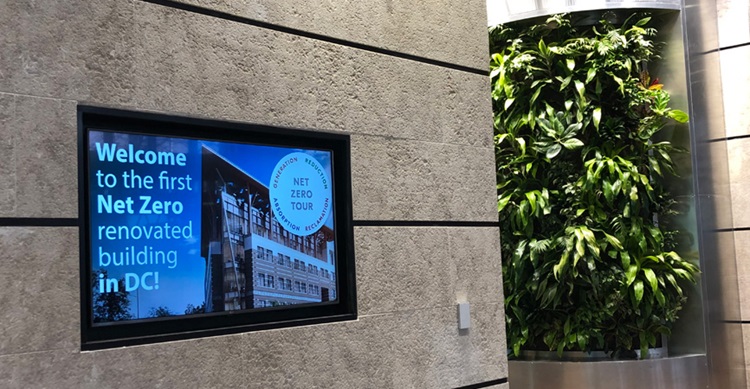
Engineering principles
To target its net zero energy goal, the now-complete renovation incorporated the engineering principles of reduction, reclamation, absorption and generation.
-
1
Reduction
By circulating chilled water through pipes in the building, a hydronic cooling system keeps the temperature comfortable while using less energy than a traditional HVAC system. Cooled ceiling surface panels evenly absorb heat from people, lights and equipment. Combined with the cooling system, heat and ventilation air are provided by a dedicated outside air system.
Other examples of reduction include radiant/hydronic cooling, lighting and workstations powered by direct current, enhanced envelope insulation and energy-efficient restrooms.
-
2
Reclamation
Through rainwater collection and cistern systems, AGU’s new headquarters reclaims water for irrigation of its hydroponic phytoremediation — better known as green — walls and the green roof, as well as for flushing the building’s toilets.
-
3
Absorption
The new headquarters includes a Huber system, which taps into DC’s municipal wastewater systems to create a heat exchange. This system, which is the first of its kind to be installed in North America, cuts down on both the energy needed to heat and cool the building and the associated costs.
-
4
Generation
More than 700 photovoltaic— better known as solar — on the renovated headquarters use the power of the sun through direct current, or DC, power modules to deliver low-voltage electricity directly to lights and workstations in the building. On days when the system generates more energy than the building needs, the surplus is contributed to the city’s power grid.
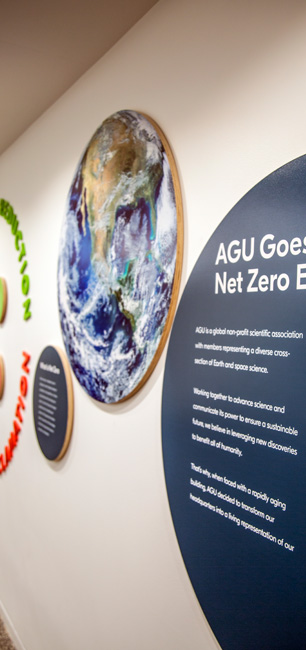
Building Features
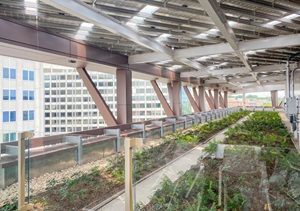
Solar panels. More than 700 photovoltaic panels at the renovated headquarters use the power of the sun to create direct current, or DC, that can be delivered to low-voltage devices, including LED lights and laptops, within the renovated headquarters.
The solar array generates electricity from the sun at the time of day when energy is the most expensive to purchase and is at peak demand in the summer. This decreases the carbon footprint of the building and helps to lower utility bills. On sunny days, the solar array can meet up to 100 percent of the renovated building’s total energy needs.
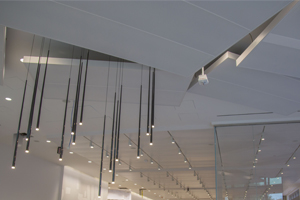
Radiant cooling. A hydronic cooling system helps to maintain an even, comfortable temperature within AGU headquarters by circulating chilled water through a network of pipes installed in ceiling panels. The cooled ceiling panels absorb the heat generated by people, lights and equipment within the building.
Air for heat and ventilation are provided by a dedicated outdoor air system (DOAS) that works in conjunction with the radiant cooling system to offer ventilation, pressurization and humidity controls for the entire building.
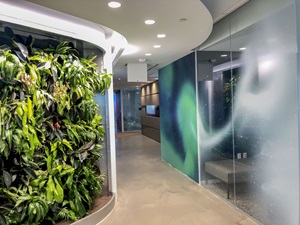
Green wall. AGU headquarters now features a centrally located, six-story hydroponic phytoremediation wall system, or green wall. The wall works with the building’s HVAC system to reduce energy loads as it improves indoor air quality.
Air from inside the building is circulated through the root systems of the wall’s live plants, which clean and filter it of carbon dioxide before sending it back into the building. The reclaimed air is tested by an air quality management system (AQMS) to determine if it is cleaner than air outside. If it passes, the pre-conditioned air returns into the building.
Traditionally, buildings are ventilated with air sourced from outside, meaning the air must be heated in winter and cooled in summer. The green wall at AGU’s headquarters can save as much as 30% of the building’s energy needs by filtering air that is already at the right temperature and humidity.
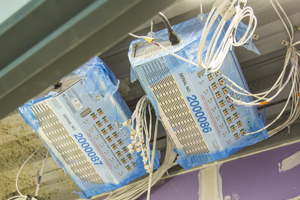
Direct current power. A loss of nearly 20% in energy efficiency occurs when electricity is converted from alternating current, known as AC, to direct current, or DC. To avoid this loss, AGU’s renovated headquarters uses the DC power generated from its solar panels to directly power low-voltage devices such as LED light bulbs, computers, printers, phone chargers and, even, kitchen appliances.
Controllers mounted in the ceilings constantly monitor the stream of DC power captured by the solar panels. If there is insufficient solar power, which can occur on cloudy days and during evening hours, the energy supplied to these lower voltage devices automatically shifts to the city’s AC power supply.
Since the 1800s, utility companies in most American cities have relied on AC, which is known for being dependable and standardized, to deliver electricity over long distances. DC was historically associated with battery power, but has seen a resurgence with portable electronic devices, including cars.
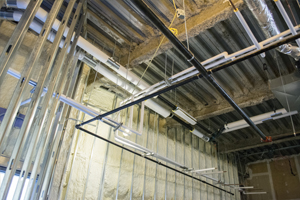
Enhanced envelope insulation. The building envelope — windows, walls, roofs — accounts for approximately 30% of the primary energy consumed by commercial buildings. It would not be possible for AGU’s headquarters to reach net zero energy without enhanced insulation, which includes spray foam to ensure the leaks are minimal and a low window-to-wall ratio.
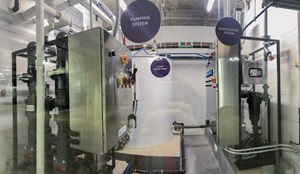
Water cistern. A water reclamation cistern collects rainwater from the roof of AGU’s headquarters, as well as condensate water from the dedicated outdoor air system. Water is pumped from the cistern through a purification system so it can be used to flush toilets and irrigate plants on the building’s green wall and rooftop garden
Reclaiming water reduces utility bills by reusing rainwater before it is sent to the city’s storm and sewer system; reclaiming water also reduces energy that would be used by pumps within the city’s water treatment systems. The cistern helps AGU’s headquarters meet D.C. water codes, which now require new construction to capture the first 1.2 inches of rainwater on site before run-off begins. This code helps to control peak flow during a storm and to protect the Anacostia and Potomac rivers.
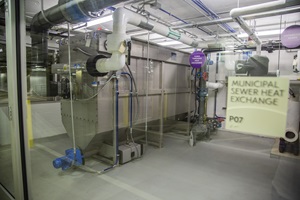
Sewer Heat Exchanger. The new headquarters uses a Huber system to cut down on the energy needed to heat and cool the building. This system, the first of its kind to be installed in North America, taps into D.C.’s municipal wastewater systems to create a heat exchange. The main purpose of a sewer heat exchanger is to transfer heat acquired inside the building during cooling season and when the conditions are right, to absorb heat from the sewer during heating season.
The Huber system diverts local wastewater to an outside settling tank before circulating it inside AGU headquarters. The wastewater is ultimately directed to an exchange system, which extracts energy (heat) from the water for heating and cooling, then returned to the sewer.
When sewer temperatures are cool, the building’s radiant cooling system uses water from the sewer heat exchange system to operate in “free cooling” mode, allowing the building’s water-to-water heat pump to be turned off. This capability eliminates the need for a cooling tower on the roof of AGU’s headquarters and saves a substantial quantity of fresh potable water.
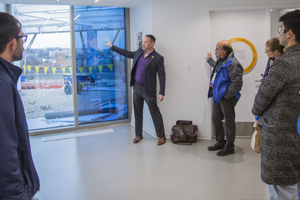
SmartGlass windows. The renovated headquarters features 929 windows — 11,227 square feet — made with SageGlass Lightzone, a triple-pane smartglass designed to control daylight, heat and glare.
The windows react to changes in sunlight by adjusting their tint to be lighter or darker. The windows also connect to the building’s interior lights so they can respond to shine more brightly, for instance, when the tint darkens — maximizing the efficiency of electrical lighting. Lastly, the triple-paned glass enhances the building’s acoustic experience by blocking noise from the busy avenues that surround the headquarters.
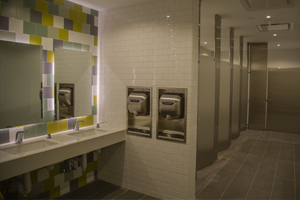
Energy-efficient restrooms. Don’t be surprised to see rainwater in the new headquarters’ toilets. AGU’s system collects stormwater via the green roof to be reused in the restroom.
AGU restrooms feature modern, low-flow sinks and toilets to limit water waste. Low-flow fixtures reduce demand for hot water from the water heater, thus, extending its lifespan.
In addition, the restrooms also utilize dynamic toilet room exhausting, which ensures restroom ventilation systems are only deployed when in use.
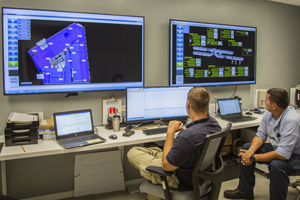
Building info data. Since 2011, D.C. has collecting data on local building’s energy and water performance on the city’s interactive web platform. AGU shared insight into its headquarters renovation to encourage other organizations to implement sustainable solutions and technologies in building or renovation projects.